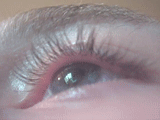Related Research Articles

Parkinsonism is a clinical syndrome characterized by tremor, bradykinesia, rigidity, and postural instability. It is found in Parkinson's disease (PD), after which it is named, dementia with Lewy bodies (DLB), Parkinson's disease dementia (PDD), and many other conditions. A wide range of causes may lead to this set of symptoms, including neurodegenerative conditions, drugs, toxins, metabolic diseases, and neurological conditions other than PD.

Torticollis, also known as wry neck, is a dystonic condition defined by an abnormal, asymmetrical head or neck position, which may be due to a variety of causes. The term torticollis is derived from the Latin words tortus for twisted and collum for neck.

Kinesiology is the scientific study of human or non-human body movement. Kinesiology addresses physiological, biomechanical, and psychological dynamic principles and mechanisms of movement. Applications of kinesiology to human health include biomechanics and orthopedics; strength and conditioning; sport psychology; methods of rehabilitation, such as physical and occupational therapy; and sport and exercise. Studies of human and animal motion include measures from motion tracking systems, electrophysiology of muscle and brain activity, various methods for monitoring physiological function, and other behavioral and cognitive research techniques.
Writer's cramp, is a disorder caused by cramps or spasms of certain muscles of the hand and/or forearm, and presents itself while performing fine motor tasks, such as writing or playing an instrument. Writer's cramp is a task-specific focal dystonia of the hand. 'Focal' refers to the symptoms being limited to one location, and 'task-specific' means that symptoms first occur only when the individual engages in a particular activity. Writer's cramp first affects an individual by interfering with their ability to write, especially for prolonged periods of time.

Dystonia is a neurological movement disorder syndrome in which sustained or repetitive muscle contractions result in twisting and repetitive movements or abnormal fixed postures. The movements may resemble a tremor. Dystonia is often intensified or exacerbated by physical activity, and symptoms may progress into adjacent muscles.

The superior frontal gyrus (SFG) also marginal gyrus, makes up about one third of the frontal lobe of the human brain. It is bounded laterally by the superior frontal sulcus.

Hyperkinesia refers to an increase in muscular activity that can result in excessive abnormal movements, excessive normal movements or a combination of both. Hyperkinesia is a state of excessive restlessness which is featured in a large variety of disorders that affect the ability to control motor movement, such as Huntington's disease. It is the opposite of hypokinesia, which refers to decreased bodily movement, as commonly manifested in Parkinson's disease.
Focal dystonia is a neurological condition, a type of dystonia, that affects a muscle or group of muscles in a specific part of the body, causing involuntary muscular contractions and abnormal postures. For example, in focal hand dystonia, the fingers either curl into the palm or extend outward without control. In musicians, the condition is called musician's focal dystonia, or simply, musician's dystonia. In sports, it may be involved in what is commonly referred to as the yips.
Neuroplasticity, also known as brain plasticity, or neural plasticity, is the ability of the brain to change continuously throughout an individual's life, e.g., brain activity associated with a given function can be transferred to a different location, the proportion of grey matter can change, and synapses may strengthen or weaken over time. The aim of neuroplasticity is to optimize the neural networks during phylogenesis, ontogeny, and physiological learning, as well as after a brain injury. Research in the latter half of the 20th century showed that many aspects of the brain can be altered even through adulthood. However, the developing brain exhibits a higher degree of plasticity than the adult brain.
Torsion dystonia, also known as dystonia musculorum deformans, is a disease characterized by painful muscle contractions resulting in uncontrollable distortions. This specific type of dystonia is frequently found in children, with symptoms starting around the ages of 11 or 12. It commonly begins with contractions in one general area such as an arm or a leg that continue to progress throughout the rest of the body. It takes roughly 5 years for the symptoms to completely progress to a debilitating state.

Blepharospasm is any abnormal contraction or twitch of the eyelid. The condition should be distinguished from the more common, and milder, involuntary quivering of an eyelid, known as myokymia. In most cases, blepharospasm symptoms last for a few days and then disappear without treatment, but in some cases the twitching is chronic and persistent, causing life-long challenges. In these cases, the symptoms are often severe enough to result in functional blindness. The person's eyelids feel like they are clamping shut and will not open without great effort. People have normal eyes, but for periods of time are effectively blind due to their inability to open their eyelids. In contrast, the reflex blepharospasm is due to any pain in and around the eye.

Spasmodic torticollis is an extremely painful chronic neurological movement disorder causing the neck to involuntarily turn to the left, right, upwards, and/or downwards. The condition is also referred to as "cervical dystonia". Both agonist and antagonist muscles contract simultaneously during dystonic movement. Causes of the disorder are predominantly idiopathic. A small number of patients develop the disorder as a result of another disorder or disease. Most patients first experience symptoms midlife. The most common treatment for spasmodic torticollis is the use of botulinum toxin type A.

Meige's syndrome is a type of dystonia. It is also known as Brueghel's syndrome and oral facial dystonia. It is actually a combination of two forms of dystonia, blepharospasm and oromandibular dystonia (OMD).
Jeffrey M. Schwartz, M.D. is an American psychiatrist and researcher in the field of neuroplasticity and its application to obsessive-compulsive disorder (OCD). He is a proponent of mind/body dualism and appeared in the 2008 Film Expelled: No Intelligence Allowed, in which he told interviewer Ben Stein that science should not be separated from religion.

Paroxysmal exercise-induced dystonia or PED is a rare neurological disorder characterized by sudden, transient, involuntary movements, often including repetitive twisting motions and painful posturing triggered by exercise or other physical exertion. PED is in the class of paroxysmal dyskinesia which are a group of rare movement disorders characterized by attacks of hyperkinesia with intact consciousness. The term paroxysmal indicates that the episodes are sudden and short lived and usually unpredicted, and return to normal is rapid. The number of reported cases of people with PED is very small leading to difficulty in studying and classifying this disease and most studies are limited to a very small number of test subjects.

Myoclonic dystonia or Myoclonus dystonia syndrome is a rare movement disorder that induces spontaneous muscle contraction causing abnormal posture. The prevalence of myoclonus dystonia has not been reported, however, this disorder falls under the umbrella of movement disorders which affect thousands worldwide. Myoclonus dystonia results from mutations in the SGCE gene coding for an integral membrane protein found in both neurons and muscle fibers. Those suffering from this disease exhibit symptoms of rapid, jerky movements of the upper limbs (myoclonus), as well as distortion of the body's orientation due to simultaneous activation of agonist and antagonist muscles (dystonia).

Basal ganglia disease is a group of physical problems that occur when the group of nuclei in the brain known as the basal ganglia fail to properly suppress unwanted movements or to properly prime upper motor neuron circuits to initiate motor function. Research indicates that increased output of the basal ganglia inhibits thalamocortical projection neurons. Proper activation or deactivation of these neurons is an integral component for proper movement. If something causes too much basal ganglia output, then the ventral anterior (VA) and ventral lateral (VL) thalamocortical projection neurons become too inhibited, and one cannot initiate voluntary movement. These disorders are known as hypokinetic disorders. However, a disorder leading to abnormally low output of the basal ganglia leads to reduced inhibition, and thus excitation, of the thalamocortical projection neurons which synapse onto the cortex. This situation leads to an inability to suppress unwanted movements. These disorders are known as hyperkinetic disorders.
Sensory-motor coupling is the coupling or integration of the sensory system and motor system. Sensorimotor integration is not a static process. For a given stimulus, there is no one single motor command. "Neural responses at almost every stage of a sensorimotor pathway are modified at short and long timescales by biophysical and synaptic processes, recurrent and feedback connections, and learning, as well as many other internal and external variables".
Kinesia paradoxa is a phenomenon most often seen in people with Parkinson's disease where individuals who typically experience severe difficulties with the simple movements may perform complex movements easily. Specifically, kinesia paradoxa focuses on walking, referring to the sudden ability to demonstrate smooth, fluid movements in people that previously had problems with walking easily. This new discovery does not just happen to an individual randomly, but must be stimulated using various types of visual or auditory cues.
Don Vaughn is an American neuroscientist and science communicator. He is a postdoctoral scholar at UCLA's Semel Institute for Neuroscience and Behavior and adjunct faculty at Santa Clara University.
References
- ↑ Sankhla C, Lai EC, Jankovic J (November 1998). "Peripherally induced oromandibular dystonia". J. Neurol. Neurosurg. Psychiatry. 65 (5): 722–8. doi:10.1136/jnnp.65.5.722. PMC 2170345 . PMID 9810945.
- ↑ Michelotti A, Silva R, Paduano S, Cimino R, Farella M (December 2009). "Oromandibular dystonia and hormonal factors: twelve years follow-up of a case report". J Oral Rehabil. 36 (12): 916–21. doi:10.1111/j.1365-2842.2009.02007.x. PMID 19840357.
- ↑ TEDx Talk. Federico Bitti. Cervical Dystonia. Rewiring the brain through dance. https://www.youtube.com/watch?v=DwkHK3rfKO0
- ↑ TEDx Talk . Joaquin Farias. Dystonia. Your movement can heal your brain. https://www.youtube.com/watch?v=czW-xBvDtHY
- ↑ Glove and Mail. Choosing music over meds, one man's quest to retrain his brain to overcome dystonia. https://www.youtube.com/watch?v=IpcXkV_ex8Y
- ↑ Farias J. Limitless. How your movements can heal your brain. An essay on the neurodynamics of dystonia. Galene editions 2016
- ↑ Farias J. Intertwined. How to induce neuroplasticity. A new approach to rehabilitate dystonias. Galene editions 2012.
| This article about a disease, disorder, or medical condition is a stub. You can help Wikipedia by expanding it. |